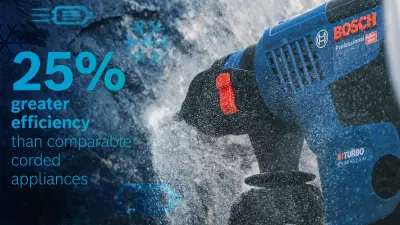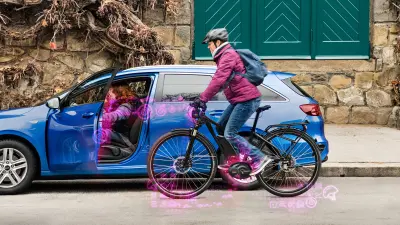Ice climbing with cordless power tools: a 1,000-watt ascent
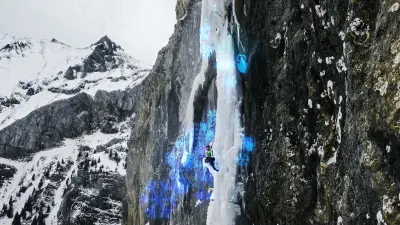
Together with his team, the extreme climber Bernhard Witz climbs icefalls and towering pillars, entrusting his life to the rope he hangs from — and the steel anchors they’re attached to. Here, he offers his thoughts on the similarities between climbing and surfing, and explains what equipment he can’t do without.
Beta Block Super — one of Europe’s most challenging ice-climbing routes

People who earn a living wielding the likes of angle grinders, drills, impact drivers, and circular saws need their cordless tools to be powerful yet handy. The former industrial climber Bernhard Witz is one of those people. Although he now manages a digitization project in a museum, he still relies on powerful cordless tools for a daredevil pursuit — Witz is a passionate ice climber. “You immerse yourself in an entirely different world, exposed to the elements yet completely secluded,” Witz says, describing the experience of scaling frozen waterfalls and 100-meter-high ice pillars with an ice axe and rope. These climbs are fraught with danger.
Is the ice frozen solid enough to climb? What are the chances of an avalanche? “Ice climbing is like surfing — you have to be in the right place at the right time,” he says.
Witz sets up belay stations to hold his safety ropes and those of his team. Drilling holes and turning in eye-bolts, he entrusts his life, and the lives of his companions, to a line attached to these anchors. A recent adventure in the Swiss Alps took him to the Beta Block Super in the Bernese Oberland region. The following clip tells the story of why this 295-meter ice-climbing route rates as one of the most difficult in Europe:
On a spectacular ice climb with Bernhard Witz

Loading the video requires your consent. If you agree by clicking on the Play icon, the video will load and data will be transmitted to Google as well as information will be accessed and stored by Google on your device. Google may be able to link these data or information with existing data.

I don’t want to have to swap batteries when I’m hanging from a rope, drilling holes for safety anchors.
Light yet powerful, with extended run-time — the Bosch cordless rotary hammer
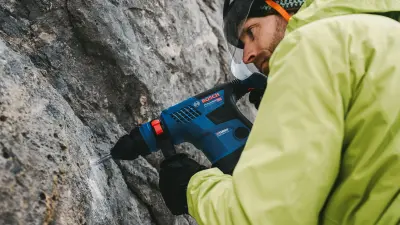
Apart from courage and skill, what Witz needs most on his ascents is the right equipment. The new Bosch Biturbo-series rotary hammer was on his packing list when he set out to climb the Beta Block Super. The tool’s brushless high-performance motor is compact yet powerful: with a diameter of just under six centimeters, it weighs a scant 750 grams. Despite its very handy dimensions, it outperforms comparable corded tools by nearly a quarter when it comes to efficiency — that is, the ratio of input to output power. All that power comes courtesy of an 18-volt lithium-ion battery. To match that kind of performance, competitors have to opt for far higher voltages or equip their tools with two batteries. This combination of powerful lithium-ion battery and brushless type motor delivers performance on a par with 1,000 watts of grid power.
Cordless power tools with advanced technology
So, what’s the secret behind this remarkable advance in technology? For one thing, there are the individual components developed by Bosch. The cooling for the electric motor and high-performance battery has been greatly improved. The brushless motor benefits from airflow and cooling inspired by automotive designs and a newly patented coil-winding pattern. The 18-volt lithium-ion battery is the first to feature laser-welded copper connections with high thermal conductivity. For another, the electronics optimize the interaction between motor and battery. But perhaps the best thing about this new circuitry is that it’s a platform that also boosts the performance and battery life of the other cordless power tools in the Bosch Biturbo series. The range includes three rotary hammers, three angle grinders, and three saws, and is being continuously extended.
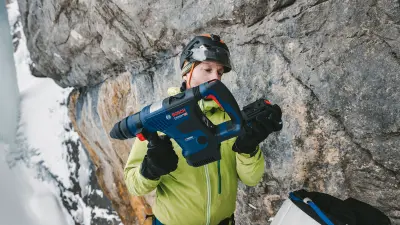
All the experts under one roof
The close collaboration among associates at Bosch Power Tools certainly spurred these innovations on. As part of a transformation process, organizational structures were broken up and rearranged according to expertise. Since this reorganization, experts for motor design, battery technology, and software have been working under one roof. Working at close quarters, they are quick to share know-how acquired over years in their various disciplines. As an extreme climber, Bernhard Witz can certainly relate to that team spirit: “I always have at least one partner with me on my ascents. You reach your own limits very quickly — and then it’s good to be able to work together to find a solution.”


